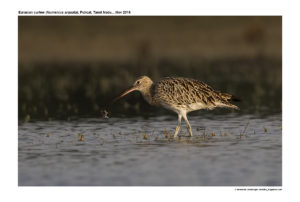Eurassian Curlew

Eurasian Curlew Numenius arquata
Etymology :
- Numenius : Greek word for noumenia – new moon, Crescent Shaped
- Arquata : Latin word for Bow shaped derived from arcus bow
Vernacular Names: Sind: Borindo, Hindi: Goar, Goungh, Bada gulinda, Sans: Kukri jalranka, Pun: Karloo, Bi: Guinyar, Ben: Choppa, Sada kastachura, Guj: Khalili, Vilayati khalili, Mar: Eurasian Kurav/Koral, Ta: Kuthirai thalai kottan, Khudure kottan, Mal: Valkokku, Sinh: Maha watuwa
Distribution in India: Widespread Winter Visitor in Coastal area and some parts of North and West India.
Description: Size of 50-60 cm. It is a large greyish-brown curlew with long bill and plain head pattern; head, neck, breast and upperparts buffy brown with dark streaking, although plumage variable; pale underwing, white rump and lower back; belly white, flanks streaked. Female averages larger, especially in having longer bill, but also on average in wing length (286–326 mm, versus 276–302 mm in male). Non-breeding adult has breast and upperparts grey-brown and underparts whiter.
Habitat: It is found in peat bogs, fens, upland moors (where prefers areas of relatively heterogeneous vegetation), damp grassland, grassy or boggy open areas in forest, extensive farmland, swampy and dry heathland, dune valleys and coastal marshes during breeding. In non-breeding period, chiefly on muddy coasts, bays and estuaries; also regularly on muddy shores of inland lakes and rivers
Food Habits: They insects, annelids, molluscs, occasionally seeds and berries during breeding. Non-breeding diet includes smaller annelids, bivalves, crustaceans in intertidal areas, fly larvae in grassland; occasionally tadpoles, small fish and fruits. Long-billed females tend to forage more on intertidal flats, feeding on molluscs, crabs and Polychaeta, while shorter-billed males tend to feed more on lumbricids on cultivated grassland. It also steals food from smaller shore birds and in return also suffers from kleptoparasitism by Seagulls
Breeding Habits: They breed in April- July in Europe. They are monogamous and territorial, with most territory defense by male, usually using undulating display flight, which is most frequently witnessed early during breeding season. High degree of site fidelity and pair-bond can be maintained between years .Two females may occasionally lay in same nest. The nest is typically in open, often in grass or sedge cover; a large depression, lined with dry grass and feathers, constructed by male. It lays a clutch of 2–5 eggs with laying interval of 1–2 days. The incubation period is 26–30 days, by both sexes equally or mainly by female, starting on clutch completion. Both adults care for young, the fledging period is 32–38 days, with females frequently deserting family group approximately halfway through this period, even earlier in late broods.